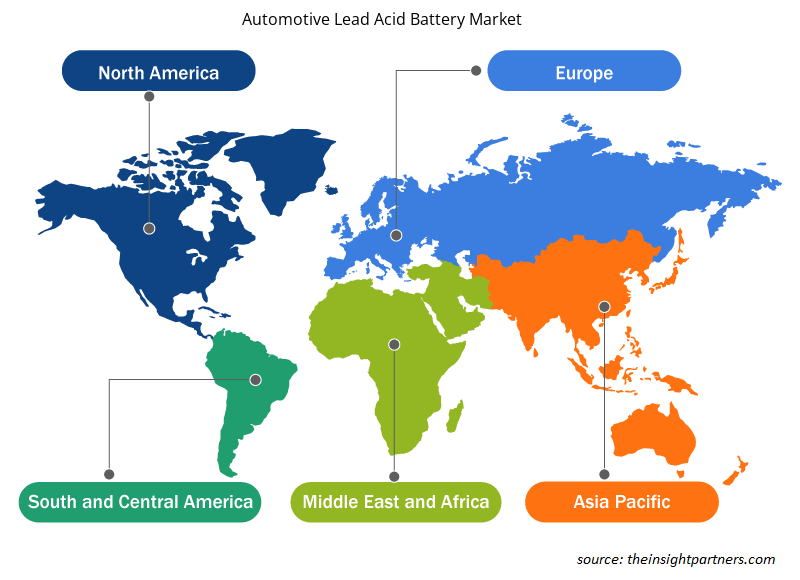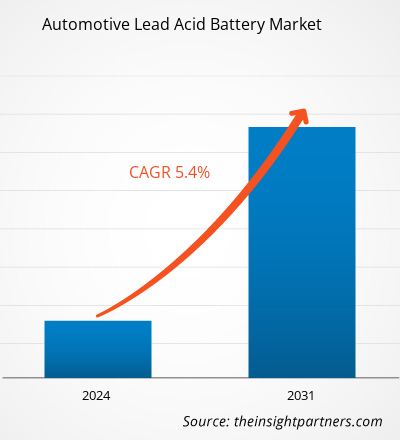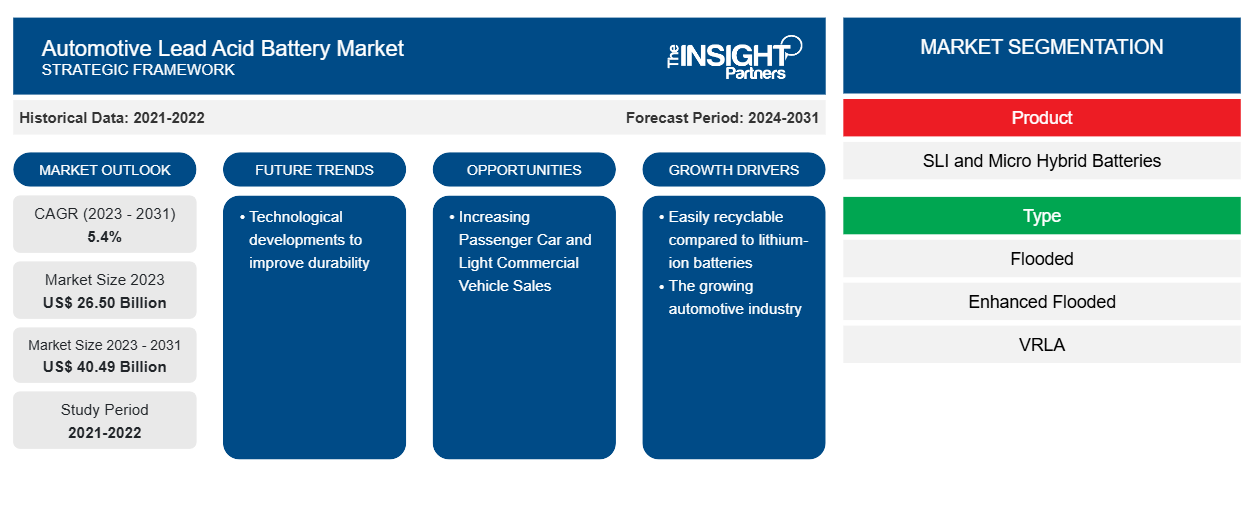Se proyecta que el mercado de baterías de plomo-ácido para automóviles crecerá de 26.500 millones de dólares en 2023 a 40.490 millones de dólares en 2031; se espera que se expanda a una CAGR del 5,4% entre 2023 y 2031. Se anticipa que el desarrollo tecnológico para mejorar la durabilidad será una tendencia clave en el mercado.CAGR of 5.4% from 2023 to 2031. Technological development to improve durability is anticipated to be a key trend in the market.
Análisis del mercado de baterías de plomo-ácido para automóviles
En comparación con otros tipos de baterías recargables, las baterías de plomo-ácido son menos costosas. La tasa de autodescarga de esta batería es de alrededor del 40% por año. Una batería de plomo-ácido funciona de manera eficaz tanto a altas como a bajas temperaturas. La tecnología empleada en estas baterías es madura. Una batería de plomo-ácido, cuando se utiliza correctamente, puede durar mucho tiempo y brindar un servicio confiable. Las baterías de plomo-ácido pueden proporcionar grandes corrientes de sobretensión, lo que las hace ideales para aplicaciones que requieren una ráfaga rápida de energía, como las baterías de arranque de automóviles. Por lo tanto, se espera que la demanda de baterías de plomo-ácido para automóviles crezca durante el período de pronóstico.
Descripción general del mercado de baterías de plomo-ácido para automóviles
Una batería de plomo-ácido para automóviles es un dispositivo recargable que almacena energía eléctrica en forma de energía química. Está formada por muchas celdas conectadas en serie, cada una de las cuales contiene una serie de placas de plomo-dióxido y esponja sumergidas en una solución de ácido sulfúrico. Las baterías de plomo-ácido funcionan de manera eficaz en una variedad de situaciones climáticas . Tienen una gran potencia de arranque, lo que proporciona una corriente de arranque adecuada incluso en temperaturas extremas. Esta característica hace que las baterías de plomo-ácido sean una excelente opción para automóviles tanto en climas fríos como cálidos. Por lo tanto, se espera que la demanda de baterías de plomo-ácido aumente durante el período de pronóstico.
Personalice este informe según sus necesidades
Obtendrá personalización en cualquier informe, sin cargo, incluidas partes de este informe o análisis a nivel de país, paquete de datos de Excel, así como también grandes ofertas y descuentos para empresas emergentes y universidades.
- Obtenga las principales tendencias clave del mercado de este informe.Esta muestra GRATUITA incluirá análisis de datos, desde tendencias del mercado hasta estimaciones y pronósticos.
Impulsores y oportunidades del mercado de baterías de plomo-ácido para automoción
Las baterías de plomo-ácido son fácilmente reciclables en comparación con las baterías de iones de litio, lo que favorece el crecimiento del mercado.
El reciclaje de baterías implica la eliminación y neutralización cuidadosa del ácido sulfúrico de las baterías usadas. Este procedimiento limita la descarga de ácido sulfúrico peligroso al medio ambiente, lo que reduce el peligro de contaminación del suelo y el agua. Las baterías de iones de litio no contienen sustancias químicas tóxicas, mientras que las baterías de plomo-ácido sí. Ambos tipos de baterías son reciclables. Sin embargo, las baterías de plomo-ácido se reciclan con mayor facilidad en la mayoría de los lugares del mundo que las baterías de iones de litio. Aproximadamente el 95% de los materiales de las baterías de plomo-ácido son reciclables, lo que las convierte en una opción responsable con el medio ambiente. Por lo tanto, se espera que la demanda de baterías de plomo-ácido aumente durante el período de pronóstico.
Aumento de las ventas de turismos y vehículos comerciales ligeros
Según el artículo publicado en el Economic Times, las ventas al por mayor de automóviles de pasajeros en la India alcanzaron un nuevo récord de 42.18.746 unidades en el año fiscal 2023-24. Además, según la Asociación China de Fabricantes de Automóviles, las exportaciones de vehículos comerciales de China alcanzaron las 74.000 unidades en enero de 2024. Las baterías de plomo-ácido son las preferidas para el arranque, la iluminación y el encendido (SLI) en un automóvil. Por lo tanto, se espera que el aumento de las ventas de vehículos de pasajeros y comerciales ligeros impulse la demanda de baterías de plomo-ácido durante el período de pronóstico.SLI) in an automobile. Thus, increasing sales of passenger and light
Análisis de segmentación del informe de mercado de baterías de plomo y ácido para automóviles
Los segmentos clave que contribuyeron a la derivación del análisis del mercado de baterías de plomo ácido para automóviles son el producto y el usuario final.
- Según el producto, el mercado se divide en baterías SLI y microhíbridas.SLI and micro-hybrid batteries.
- Según el tipo, el mercado se segmenta en inundado, inundado mejorado y VRLA)VRLA)
- En función de los usuarios finales, el mercado está segmentado en turismos, vehículos comerciales ligeros, vehículos comerciales medianos y vehículos industriales pesados.
- En 2023, el segmento SLI representó una importante participación de mercado. La batería SLI es una batería de plomo-ácido recargable y se utiliza ampliamente en diferentes automóviles.
Análisis de la cuota de mercado de baterías de plomo-ácido para automóviles por geografía
Según la región, el mercado está segmentado en América del Norte, Europa, Asia Pacífico, Medio Oriente y África, y América del Sur y Central.
La fuerte presencia de Europa en materia de innovación y medidas medioambientales en el sector de la automoción tiene un impacto considerable en la industria de baterías de plomo-ácido para la automoción. Se espera que Alemania, el Reino Unido y Francia sean los países clave en el mercado europeo de baterías de plomo-ácido para la automoción. Por otro lado, se espera que Asia-Pacífico sea el mercado más rentable durante el período de proyección debido al crecimiento del sector de la automoción en la región.
Perspectivas regionales del mercado de baterías de plomo-ácido para automóviles
Los analistas de Insight Partners explicaron en detalle las tendencias y los factores regionales que influyen en el mercado de baterías de plomo ácido para automóviles durante el período de pronóstico. Esta sección también analiza los segmentos y la geografía del mercado de baterías de plomo ácido para automóviles en América del Norte, Europa, Asia Pacífico, Oriente Medio y África, y América del Sur y Central.

- Obtenga datos regionales específicos para el mercado de baterías de plomo-ácido para automóviles
Alcance del informe de mercado de baterías de plomo-ácido para automóviles
| Atributo del informe | Detalles |
|---|---|
| Tamaño del mercado en 2023 | US$ 26.50 mil millones |
| Tamaño del mercado en 2031 | US$ 40,49 mil millones |
| CAGR global (2023 - 2031) | 5,4% |
| Datos históricos | 2021-2022 |
| Período de pronóstico | 2024-2031 |
| Segmentos cubiertos | Por producto
|
| Regiones y países cubiertos | América del norte
|
| Líderes del mercado y perfiles de empresas clave |
|
Densidad de actores del mercado de baterías de plomo-ácido para automoción: comprensión de su impacto en la dinámica empresarial
El mercado de baterías de plomo ácido para automóviles está creciendo rápidamente, impulsado por la creciente demanda de los usuarios finales debido a factores como la evolución de las preferencias de los consumidores, los avances tecnológicos y una mayor conciencia de los beneficios del producto. A medida que aumenta la demanda, las empresas amplían sus ofertas, innovan para satisfacer las necesidades de los consumidores y aprovechan las tendencias emergentes, lo que impulsa aún más el crecimiento del mercado.
La densidad de actores del mercado se refiere a la distribución de las empresas o firmas que operan dentro de un mercado o industria en particular. Indica cuántos competidores (actores del mercado) están presentes en un espacio de mercado determinado en relación con su tamaño o valor total de mercado.
Las principales empresas que operan en el mercado de baterías de plomo ácido para automoción son:
- Clarios
- Tecnología Energética CSB Co., Ltd.
- Sistemas energéticos
- Compañía manufacturera de East Penn
- Industrias Exide Limitada
- GS Yuasa Internacional Ltd.
Descargo de responsabilidad : Las empresas enumeradas anteriormente no están clasificadas en ningún orden particular.

- Obtenga una descripción general de los principales actores clave del mercado de baterías de plomo ácido para automóviles
Noticias y desarrollos recientes del mercado de baterías de plomo-ácido para automóviles
El mercado de baterías de plomo-ácido para automóviles se evalúa mediante la recopilación de datos cualitativos y cuantitativos a partir de una investigación primaria y secundaria, que incluye publicaciones corporativas importantes, datos de asociaciones y bases de datos. A continuación, se enumeran algunos de los avances en el mercado de baterías de plomo-ácido para automóviles:
- GS Yuasa Corporation anunció que Tata AutoComp GY Batteries Private Ltd. (“TGY”), una filial con sede en India que participa en el capital de la subsidiaria GS Yuasa International Ltd. (“GS Yuasa”), tiene como objetivo duplicar su capacidad de producción anual de baterías de plomo-ácido para motocicletas a 8,4 millones de unidades. Además, TGY fortalecerá su producción de baterías de plomo-ácido para automóviles, con un enfoque en baterías de plomo-ácido de alto rendimiento para vehículos ecológicos, como vehículos con sistema de arranque y parada, cuya demanda se espera que siga creciendo en los próximos años. (Fuente: GS Yuasa Corporation, comunicado de prensa, diciembre de 2021)
Informe sobre el mercado de baterías de plomo y ácido para la industria automotriz: cobertura y resultados
El pronóstico del mercado de baterías de plomo ácido para automóviles se estima en función de varios hallazgos de investigación primaria y secundaria, como publicaciones de empresas clave, datos de asociaciones y bases de datos. El informe de mercado "Tamaño y pronóstico del mercado de baterías de plomo ácido para automóviles (2021-2031)" proporciona un análisis detallado del mercado que cubre las siguientes áreas:
- Tamaño y pronóstico del mercado de baterías de plomo-ácido para automóviles a nivel mundial, regional y nacional para todos los segmentos clave del mercado cubiertos bajo el alcance
- Tendencias del mercado de baterías de plomo ácido para automóviles, así como dinámicas del mercado, como impulsores, restricciones y oportunidades clave
- Análisis detallado de las cinco fuerzas de Porter y PEST y FODA
- Análisis del mercado de baterías de plomo-ácido para automóviles que abarca las tendencias clave del mercado, el marco global y regional, los principales actores, las regulaciones y los desarrollos recientes del mercado
- Panorama de la industria y análisis de la competencia que cubre la concentración del mercado, análisis de mapas de calor, actores destacados y desarrollos recientes en el mercado de baterías de plomo ácido para automóviles
- Perfiles detallados de empresas.
- Análisis histórico (2 años), año base, pronóstico (7 años) con CAGR
- Análisis PEST y FODA
- Tamaño del mercado, valor/volumen: global, regional y nacional
- Industria y panorama competitivo
- Conjunto de datos de Excel
Informes recientes
Informes relacionados
Testimonios
Razón para comprar
- Toma de decisiones informada
- Comprensión de la dinámica del mercado
- Análisis competitivo
- Información sobre clientes
- Pronósticos del mercado
- Mitigación de riesgos
- Planificación estratégica
- Justificación de la inversión
- Identificación de mercados emergentes
- Mejora de las estrategias de marketing
- Impulso de la eficiencia operativa
- Alineación con las tendencias regulatorias





















 Obtenga una muestra gratuita para - Mercado de baterías de plomo-ácido para automoción
Obtenga una muestra gratuita para - Mercado de baterías de plomo-ácido para automoción